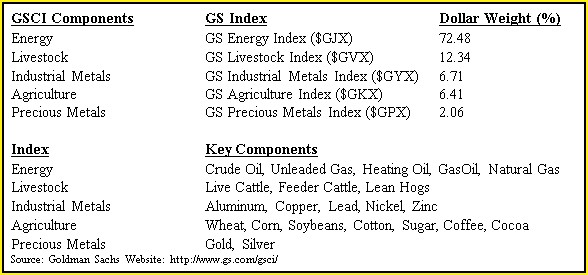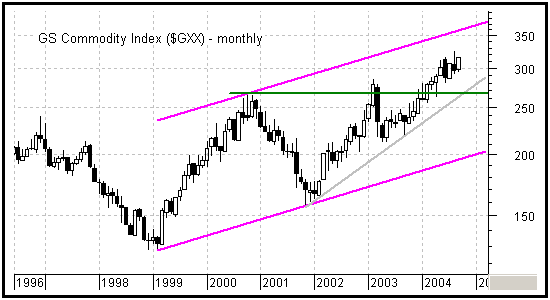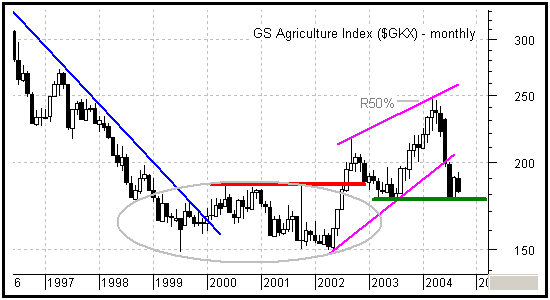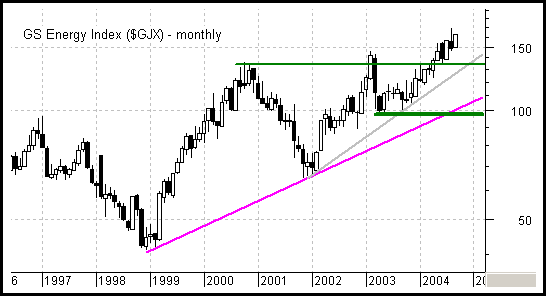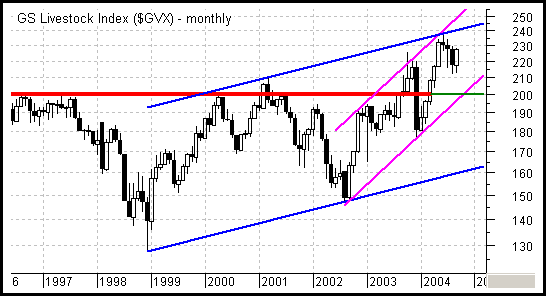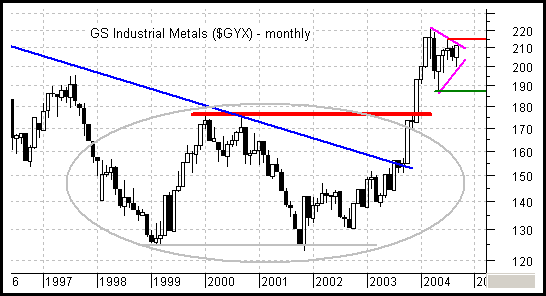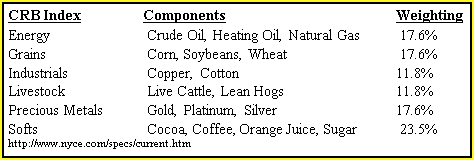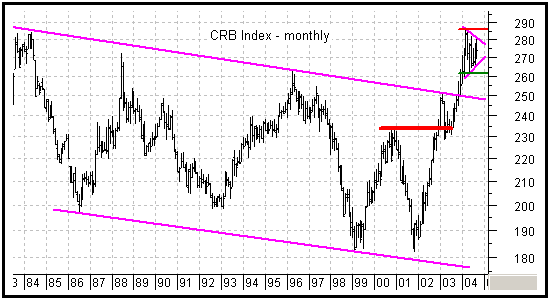
HOT TOPICS LIST
- Strategies
- Stocks
- Buy
- Investing
- Brokers
- Psychology
- Interviews
- Accumulate
- Sell
- Hold
- Spotlight
- Websites
- Candlestick Corner
- Gold & Metals
- Options Trading
LIST OF TOPICS
THE CHARTIST
Commodities: We've Only Just Begun
09/29/04 02:36:15 PM PSTby Arthur Hill
To paraphrase Edwin LeFevre, remember that commodities are never too high for you to begin buying or too low to begin selling.
| Even though commodity prices have risen quite sharply for an extended period, the bull market is alive and kicking. Since the beginning of 1999, the Goldman Sachs Commodity Index ($GXX) has more than doubled and remains in a strong uptrend. While a breakdown of the index reveals that energy dominates, most of the components are in strong uptrends as well. As the following analysis confirms, the long-term tide has shifted from bearish to bullish for most commodity groups and a general rise in prices is expected to continue. The Goldman Sachs Commodity Index can be divided into five commodity groups. As Figure 1 shows, energy completely dominates the index with more than 70% of the dollar weight. Livestock is the next closest competitor with more than 12%, and the remaining three components make up less than 16%.
Figure 1: GOLDMAN SACHS COMMODITIES INDEX COMPONENTS
Strength or weakness in these individual groups can tell us if the gains in $GXX are limited to a few commodities, such as oil and gas, or if these gains are part of a broader move in all commodity groups. The following is a look at the price charts for each commodity group within $GXX (Figure 2).
Figure 2: GOLDMAN SACHS COMMODITIES INDEX ($GXX)
Agriculture: The three-year base (gray oval) and breakout are the most important features of the Goldman Sachs Agriculture Index ($GKX) chart (Figure 3). The index broke out with a strong move above 200 and ultimately retraced 50% of the prior decline with a rising wedge. The break below the lower (magenta) trendline is negative, but there is still a lot of support around 180 from broken resistance and the 2003 lows (green line). This index has been the weakest of the five components recently, but it is still too early to turn bearish. As long as the 2003 lows hold (175), the decline is viewed as a throwback or correction to broken resistance. Figure 3: GOLDMAN SACHS AGRICULTURAL INDEX ($GKX)
Energy: As expected, the chart for the Goldman Sachs Energy Index ($GJX) in Figure 4 looks similar to the chart for the Goldman Sachs Commodity Index ($GXX). The index broke to a new high in early 2003 and again in the summer of 2004. The trend is clearly up and the move to 150 can only be considered bullish, with further gains expected until proven otherwise. Minor support at 134 is the first level to watch for signs of weakness. A move below this level would break the trendline extending up from January 2002 and support from broken resistance. While this would be negative, key support is just below 100 and it would take a move below this level to turn outright bearish.
Figure 4: GOLDMAN SACHS ENERGY INDEX ($GJX)
Livestock: The Goldman Sachs Livestock Index ($GVX) broke above an important resistance level in 2003 and moved to a multiyear high this year (Figure 5). There are two rising price channels visible: one extending up from the 1998 low and the other extending up from the 2002 low. The upper trendlines converge around 240 to mark a resistance level and the index pulled back over the last few months. This pullback is treated as a correction or consolidation and would not threaten the uptrend unless the index moves below 200. Such a decline would break the trendline extending up from September 2002 and support from broken resistance. As long as 200 holds, the bulls rule (quite literally for this index) and higher prices are expected.
Figure 5: GOLDMAN SACHS LIVESTOCK INDEX ($GVX)
Industrial metals: The Goldman Sachs Industrial Metals Index ($GYX) is one of the strongest components of the Goldman Sachs Commodity Index ($GXX) (Figure 6). The index formed a huge base from 1998 to 2003 (gray oval) and then broke above resistance at 175 with a sharp move at the end of 2003. The advance carried above 200 in 2004 and the index has consolidated this year. The pattern shaping up looks like a pennant, which is a bullish continuation pattern. A move above the July high (215) would signal a continuation higher. Should an upside breakout fail to materialize, a move below the 2004 low (187) would open the door to a deeper pullback.
Figure 6: GOLDMAN SACHS INDUSTRIAL METALS INDEX ($GYX)
Precious metals: The Goldman Sachs Precious Metals Index ($GPX) formed a massive base from 1997 to 2002 and broke resistance at 450 with a big move (Figure 7). The pattern looks like a big double bottom and the upside projection was to around 550 (450 - 350 = 100, 450 + 100 = 550). Even though the index reached the upside target, the bulls remained firmly in control as the trading range around 550 looks like a consolidation (gray circle). As long as the blue trendline and 2004 low hold (497), an upside resolution is expected. A move below 497 would be negative and this would then target a decline back to broken resistance around 450.
Figure 7: GOLDMAN SACHS PRECIOUS METALS INDEX ($GPX)
Three things are clear from the technical assessment of each group. First, massive bases formed in agriculture, industrial metals, precious metals, and livestock. Although a base did not form in energy, it was the first to break out to new highs (2000) and the first to establish an uptrend. Second, four of the five components forged major breakouts in 2002 and 2003. The exception is, of course, energy, which broke resistance in 2000 and recorded another new high in 2003. Third, four of the five components remain in an uptrend. The exception is agriculture, which is the weakest as the recent decline returned to the prior breakout zone (see Figure 8).
Figure 8: CRB INDEX COMPONENTS
Analysis of the CRB Index reinforces the bullish argument for commodities in general. This index is a basket of 17 commodities and the groups are more equally weighted. As such, this index provides a more balanced picture of commodities overall than the Goldman Sachs Commodity Index ($GXX) (see Figure 9).
Figure 9: CRB INDEX WEIGHTINGS
As the price chart for the CRB Index reveals (Figure 10), a major bull market is not only under way, but also appears to be in the early stages. After more than 20 years of declining prices, the CRB Index broke out of a large falling price channel with a strong move in 2003 and moved to its highest level in over 20 years. This is no small feat. Note that the index broke above the 2000 high with a surge late in 2002.
Figure 10: CRB INDEX
After a 100-point move in just over two years, the index has consolidated most of 2004 with a pennant (magenta trendlines). These are bullish continuation patterns and a break above the pennant high (286) would open the door to the next segment of the bull market. While a move below the pennant low (262) would be negative, it would still be viewed as a pullback or correction with support expected between 230 and 250. The conclusion is clear. The bull market in commodities is relatively new and looks set to continue for many years to come. Even though energy dominates the Goldman Sachs Commodity Index ($GXX), the other components are also strong and the bull market in commodities is broad based. From the five component charts, it appears that industrial metals and precious metals may be the next to resume their uptrends. Both are consolidating after breakouts and strong gains. Look for consolidation breakouts to signal a continuation higher.
Arthur Hill is editor and publisher at www.tdtrader.com, a website specializing in trading strategies, sector/industry specific breadth stats and overall technical analysis. He can be reached at arthurh@tdtrader.com.
References Goldman Sachs website: http://www.gs.com/gsci/ Charts courtesy of MetaStock Professional 7.22 Current and past articles from Working Money, The Investors' Magazine, can be found at Working-Money.com. |
Arthur Hill is currently editor and publisher of TDTrader.com, a website specializing in trading strategies, sector/industry specific breadth stats and overall technical analysis. He is a full member of the Society of Technical Analysts (STA London) and teaches the Momentum module for the STA diploma exam. Prior to TD Trader, Arthur worked for Stockcharts.com and wrote much of the site's education center.
| Title: | Editor/Publisher |
| Company: | TDTrader.com |
| Website: | www.tdtrader.com |
| E-mail address: | arthurh@tdtrader.com |
Traders' Resource Links | |
PRINT THIS ARTICLE

|

Request Information From Our Sponsors
- StockCharts.com, Inc.
- Candle Patterns
- Candlestick Charting Explained
- Intermarket Technical Analysis
- John Murphy on Chart Analysis
- John Murphy's Chart Pattern Recognition
- John Murphy's Market Message
- MurphyExplainsMarketAnalysis-Intermarket Analysis
- MurphyExplainsMarketAnalysis-Visual Analysis
- StockCharts.com
- Technical Analysis of the Financial Markets
- The Visual Investor
- VectorVest, Inc.
- Executive Premier Workshop
- One-Day Options Course
- OptionsPro
- Retirement Income Workshop
- Sure-Fire Trading Systems (VectorVest, Inc.)
- Trading as a Business Workshop
- VectorVest 7 EOD
- VectorVest 7 RealTime/IntraDay
- VectorVest AutoTester
- VectorVest Educational Services
- VectorVest OnLine
- VectorVest Options Analyzer
- VectorVest ProGraphics v6.0
- VectorVest ProTrader 7
- VectorVest RealTime Derby Tool
- VectorVest Simulator
- VectorVest Variator
- VectorVest Watchdog

